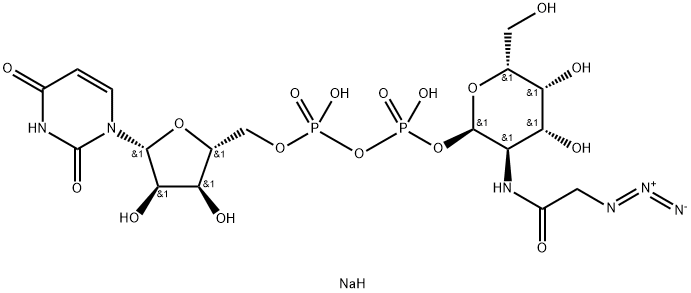UDP-ALPHA-D-N-ACETYLGLUCOSAMINE, DISODIUM SALT
Synonym(s):UDP-α-D-N-Acetylglucosamine, Disodium Salt - CAS 91183-98-1 - Calbiochem;UDPAG;UDP-GlcNAc;UDP-GlcNAc, 2Na;UDP-N-acetylglucosamine
- CAS NO.:91183-98-1
- Empirical Formula: C17H28N3NaO17P2
- Molecular Weight: 631.35
- MDL number: MFCD00799985
- EINECS: 293-820-5
- SAFETY DATA SHEET (SDS)
- Update Date: 2025-12-16 21:30:20

What is UDP-ALPHA-D-N-ACETYLGLUCOSAMINE, DISODIUM SALT?
Chemical properties
White to off-white crystalline powder
The Uses of UDP-ALPHA-D-N-ACETYLGLUCOSAMINE, DISODIUM SALT
Uridine-5'-diphospho-N-acetylglucosamine sodium salt is used as a chemical reagent in studies relating to the synthesis of immunogens.
The Uses of UDP-ALPHA-D-N-ACETYLGLUCOSAMINE, DISODIUM SALT
GlcNAc transferase substrate
The Uses of UDP-ALPHA-D-N-ACETYLGLUCOSAMINE, DISODIUM SALT
Uridine 5′-diphospho-N-acetylglucosamine (UDP-GlcNAc) sodium salt has been used:
- as a component of reaction cocktail in endoplasmic reticulum to Golgi transport assay
- as a reference standard for the quantification of UDP-GlcNAc in liver tissues using high-performance liquid chromatography (HPLC)
- in testing the glycosylation activity of O-GlcNAc transferase (OGT) against peptide substrate
What are the applications of Application
UDP-N-acetyl-D-glucosamine disodium salt is a nucleotide sugar and donor substrate for O-GlcNAc transferase.
General Description
Uridine 5′-diphospho-N-acetylglucosamine (UDP-GlcNAc) is a nucleotide sugar. It is synthesized from glucose via the hexosamine biosynthetic pathway (HBP). UDP-GlcNAc is transported actively into Golgi, nucleotide sugar transporter (NST). The levels of UDP-GlcNAc is modulated by the concentration of nutrients exposed to the cell.
Biochem/physiol Actions
Uridine 5′-diphospho-N-acetylglucosamine (UDP-GlcNAc) is a sugar donor and aids in the endomembrane glycosylation of endoplasmic reticulum and Golgi. The decreased levels of UDP-GlcNAc has an influence on the normal cellular proliferation and apoptosis. UDP-GlcNAc elicits feedback inhibition of the enzyme glutamine:fructose-6-phosphate amidotransferase (GFAT).
Properties of UDP-ALPHA-D-N-ACETYLGLUCOSAMINE, DISODIUM SALT
| storage temp. | -20°C |
| solubility | Methanol (Slightly, Heated), Water (Slightly) |
| form | Solid |
| color | White to off-White |
Safety information for UDP-ALPHA-D-N-ACETYLGLUCOSAMINE, DISODIUM SALT
Computed Descriptors for UDP-ALPHA-D-N-ACETYLGLUCOSAMINE, DISODIUM SALT
New Products
Indole Methyl Resin tert-butyl 9-methoxy-3-azaspiro[5.5]undecane-3-carboxylate Boc-His(Boc)-OH 2-CTC Resin 4-Chloro-7-tosy1-7Hpyrrolo[2,3-d]pyrimidine 5,7-Dibromo-1H-indole 2,5-dichloro-N-hydroxy-4,6-dimethylpyridine-3-carboximidamide 2,2-Dimethoxy-7-azaspiro[3.5]nonane hydrochloride 4-chloromethyl-5-methyl-1,3-dioxol-2-one (DMDO-Cl) R-2-BENZYLOXY PROPIONIC ACID 1,1’-CARBONYLDIIMIDAZOLE 1,1’-CARBONYLDI (1,2-4 TRIAZOLE) N-METHYL INDAZOLE-3-CARBOXYLIC ACID 4-((2-hydroxyethyl)thio)benzoic acid 1-(TERT-BUTOXYCARBONYL)-2-PYRROLIDINONE Methyl 6-methylnicotinate 3-Pyridineacrylic acid tert-Butyl carbazate TETRAHYDRO-2H-PYRAN-3-OL 2-((4-morpholinophenylamino) (methylthio) methylene) malononitrile 3-(4-morpholinophenylamino)-5-amino-1H-pyrazole-4-carbonitrile 2,4-dihydroxybenzaldehyde 1,3-Diethyl-1,3-Diphenylurea Methyl 2-methylquinoline-6-carboxylateRelated products of tetrahydrofuran








You may like
-
 UDP-α-D-N-Acetylglucosamine, Disodium Salt CAS 91183-98-1View Details
UDP-α-D-N-Acetylglucosamine, Disodium Salt CAS 91183-98-1View Details
91183-98-1 -
 Pyridine 99.5% HPLC /UV SpectroscopyView Details
Pyridine 99.5% HPLC /UV SpectroscopyView Details
110-86-1 -
 Guanine , 99%View Details
Guanine , 99%View Details
73-40-5 -
 Piperazine Spot supply, best priceView Details
Piperazine Spot supply, best priceView Details
110-85-0 -
 Dibutyl PhthalateView Details
Dibutyl PhthalateView Details
84-74-2 -
 Imidazole Spot supply, competitive priceView Details
Imidazole Spot supply, competitive priceView Details
288-32-4 -
 Octadecyl 3-(3,5-di-tert-butyl-4-hydroxyphenyl)propionate 98% (GC)View Details
Octadecyl 3-(3,5-di-tert-butyl-4-hydroxyphenyl)propionate 98% (GC)View Details
2082-79-3 -
 Thiourea 99% ARView Details
Thiourea 99% ARView Details
62-56-6
